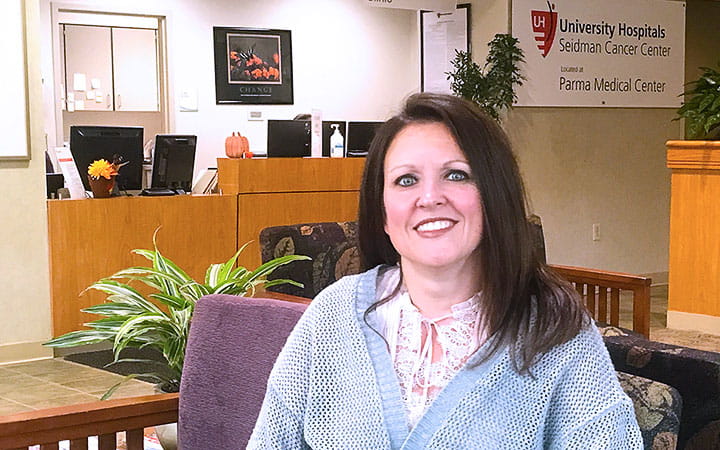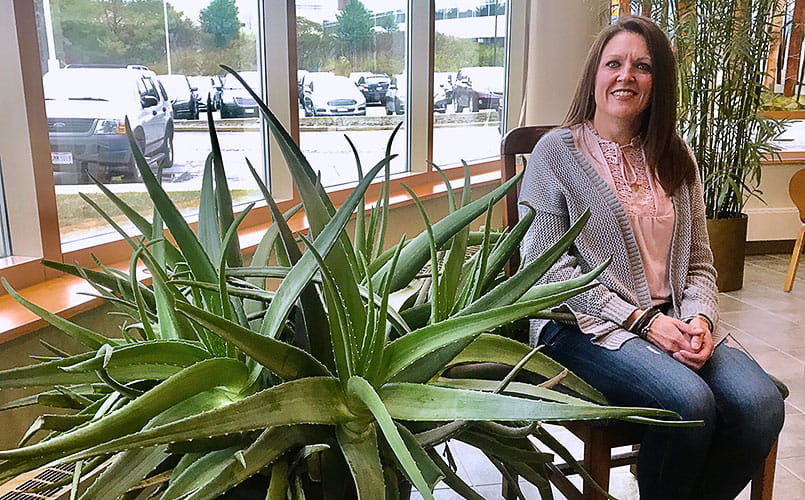Follow-Up Mammogram Finds Cancer Before It Became Invasive
October 15, 2019

Carrie Boyert exercises regularly, eats a rainbow of fruits, vegetables and proteins and was only in her early 40s. Cancer was nowhere in her family history – and certainly not part of her plan.
But cancer often comes as a curveball when those least expect it.
“How can a just 42-year-old who works out and eats great have cancer?” says Carrie. “I’m a perfect example of why you should go get screened. I had to eat my own words.”
On Oct. 2 last year, Carrie observed Breast Cancer Awareness Month by getting a screening digital mammogram with 3D tomosynthesis. Annual screening mammograms are still advised for women starting at age 40. Only the second mammogram of her life, it seemed to go well. Then a letter arrived in the mail recommending further screening.
Carrie delayed making the follow-up appointment, then cancelled it, worried that she was overreacting. Cancer? Me?
Her healthcare providers at UH were looking out for her. In 24 hours, she received phone calls from three different people – her OB/GYN, a radiation tech and a scheduler – questioning the cancellation. They all urged her to go for the more advanced screening.
“When cancers develop, blood vessels increase to supply the rapidly growing cells, and calcium clusters develop,” says Kristine Herrmann-Pelagalli, MD, Carrie’s OB/GYN. “Mammograms are very good at detecting calcium clusters, and we advised additional imaging to evaluate the right breast.”
“You really need to go for this appointment”
Minutes after the additional imaging was reviewed, Carrie received a call from Dr. Pelagalli that a biopsy was needed, which confirmed the physician’s suspicion. Carrie had a 2.7-centimeter noninvasive ductal carcinoma in her right breast – and doctors said it was on the brink of becoming invasive.
“Another month of two of waiting to have that mammogram could have changed everything for me,” says Carrie.
She was scheduled for surgery at UH Ahuja Medical Center, where Breast Surgeon Jill Dietz, MD, removed a grape-sized collection of calcifications from Carrie’s right breast in a partial mastectomy/lumpectomy. Dr. Dietz also used Hidden Scar™ surgical technique, an oncoplastic procedure that moves breast tissue around to prevent breast deformity after tumor remove, reduces excess skin and minimizes scarring.
A soothing balm

Carrie’s partial mastectomy was followed by 20 radiation therapy sessions on the new linear accelerator at the UH Seidman Cancer Center at UH Parma Medical Center. While the radiation is localized to the breast, the treatment can still cause skin irritation and discomfort, which Carrie described as her skin feeling “asleep.”
She found that the aloe plants so commonplace in her family’s Brooklyn Heights greenhouse had soothing properties to relieve the dryness and discomfort caused by radiation. The American Cancer Society reports that aloe has been used since the 1930s for skin reactions to radiation therapy.
Radiation Oncologist Kevin Kelley, MD, PhD, who started working at UH Parma the month Carrie began her treatments, had long gifted small aloe plants to all of his patients. He was delighted when Carrie’s husband, Matt, saw the relief she received from the aloe plants and decided to donate several plants.
Seven enormous aloe plants from a three-generation family business, AJ Boyert and Sons Inc. in Brooklyn Hts., now stand in the light-filled lobby of the UH Seidman Cancer Center at UH Parma Medical Center. Staff now send radiation patients home with cleaned leaves from the plants, which they can break pieces off and use as needed.
“There are a lot of people who will have immediate relief from pain with these plants,” says Carrie.
Peace of mind with a mammogram
One year after the fateful mammogram that led her down the twisting path of her cancer journey, Carrie returned for her annual mammogram. She is clear of cancer.
”I feel much larger relief to know that, after my mammogram, the cancer is gone,” says Carrie. “You’ll never find any woman that looks forward to a mammogram. It’s not comfortable, but it’s necessary.”
Tags: Breast Cancer, Cancer


